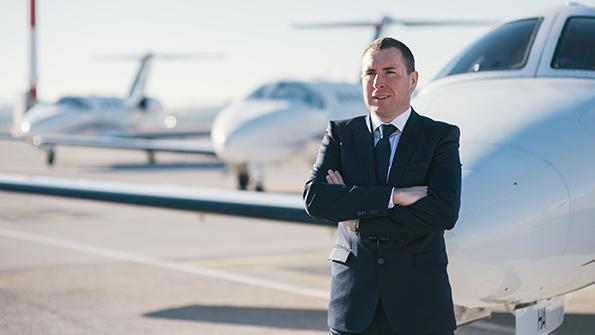
The executive air charter industry is suffering from the effects of the COVID-19 pandemic, but a vigorous rebound may happen over the coming months, according to Bernhard Fragner, CEO of Europe’s largest small-jet air-taxi operator, GlobeAir.
“If EU countries come to an agreement on how to lift travel restrictions, then the business will come back strongly, following a pattern similar to the recovery in 2008-09,” he says.
A key factor is that large companies are likely to sell their business jets, the ownership of which is difficult to justify when job cuts are on the agenda. They will switch to chartering, Fragner predicts.
GlobeAir may be in the sweet spot. Downsizing—using a light jet instead of a large-cabin one—is a probable trend, Fragner says. GlobeAir operates 20 Cessna Citation Mustangs.
Moreover, “a lot of business travelers will be scared and may want to book private flights instead of on airlines. There are people we can educate,” says Fragner. In fact, first-timers have begun to show up: On May 19, 48% of GlobeAir’s passengers had never been on a business jet before.
Since March, GlobeAir’s activity has roller-coastered. The first two weeks of that month saw a 21% uptick in activity, compared to the same period in 2019, as passengers wanted to fly home. The second half of the month saw a 65% drop and April was worse, at minus 75%.
But demand started picking up in early May. “Our revenues have doubled, compared to the same period in April,” says Fragner. Travel restrictions have started to be relaxed, and some business passengers—but not leisure travelers —are back. Most of GlobeAir’s recent flights have taken place in Switzerland and Germany.
Those GlobeAir employees who usually work in offices now work from home, except if they are part of the crisis team. Fragner works both at home and the office.
Crews henceforth work in fixed pairings. In case a pilot tests positive for COVID-19, a crew can be isolated easily. Pilots wear masks, except in the cockpit.
Passengers have to wear masks—which GlobeAir can supply—if they do not belong to the same household. Textile items, such as pillows, can no longer be found in GlobeAir Mustangs’ cabins.
To adapt to the new environment, the operator has begun using a business model in which aircraft do not have bases.
GlobeAir has used a “floating base model” since Day One, explains Fragner. Aircraft do not return to a base after a revenue flight, they just fly to the next airport where a passenger is to be picked up. “With this model, we are fully flexible and can optimize empty sectors as much as possible,” he emphasizes.
With the semi-based model, GlobeAir is looking for a way to live with remaining restrictions on air travel and stricter health-protection standards.
“We expect those not only in air travel but also in hotels and other travel chain elements. This will limit us in . . . where crews stay overnight. This means we will define a set of ´safe airports´ where we return after we have delivered our service,” Fragner stresses. “Safe airports for us are places where we can park aircraft, have access to our aircraft, where crew can stay overnight (or back home), spots where we can safely swap crew if needed.
“Actually we have been operating this model since the general lockdown in mid-March . . . at Paris Le Bourget, London Biggin Hill, Vienna and Linz [Austria] and Augsburg [Germany]. We will carefully evaluate the situation and define this set of airports, which might be up to 20-30 safe places [a greater number than the usual number of bases for a business-jet operator].”
Salespeople have been hired to find new customers. “We will be aggressive over the next few months. This is key for us to survive,” says Fragner.
He expresses reasonable optimism about the near future, noting: “The company is a private investment. We have liquidity to continue at a low level of activity until July, and the government is supporting us with a short-time working scheme.”
GlobeAir’s payroll stands at 178, up from 156 last spring.
Last year, the company enjoyed growing demand but the opportunity was wasted because of unsatisfactory fleet availability. Breakdowns happened and aircraft could not be fixed rapidly. They resulted in a number of aircraft-on-ground (AOG) situations.
GlobeAir since has hired engineers and created a maintenance coordination center. Working on a 24/7 basis, four employees now decide to dispatch a maintenance engineer to the AOG location or tap an MRO service provider.
“We increased our parts inventory and hired a fleet reliability manager,” Fragner says. Failure patterns were identified. “We saw we could avoid 90% of AOGs by replacing parts earlier. We have seen a massive reduction in AOGs.”
Some numbers were disappointing in 2019. The year ended with fewer flights —9,800—than in 2018, and empty legs were more frequent. But the average €3,480 per passenger-hour was the best price recorded since GlobeAir began operating in 2008.
The most popular routes in 2019 were Paris to Nice and Geneva to Nice, notes Fragner.
Meanwhile, plans for fleet replacement have been postponed.
